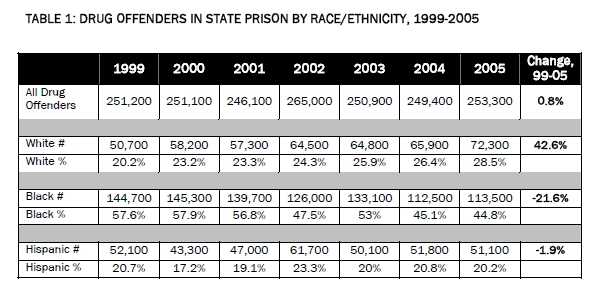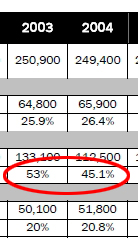when Justice lies
June 27th, 2012(read the book free online – get a copy for your Kindle – read the Reddit AMA)
When you are sworn into Federal Court, you are exhorted to tell “the truth, the whole truth, and nothing but the truth.” Each of these phrases carries a slightly different angle against any possible lie – not only are you swearing to speak no lies, but also to not hold any part of the truth back, and to not mix in lies among the truth you do tell.
And so by its own standards, the US Department of Justice’s Bureau of Justice Statistics has been openly and unabashedly lying about the racial divisions that remain within the American penal system for at least the past seven years. It’s a lie so patently absurd that if our current President was incarcerated, the Department of Justice would pretend he wasn’t there, and whitewash his existence from their racial prisoner data entirely.
A report by The Sentencing Project used data provided by the Bureau of Justice Statistics to come to the cheery conclusion that over the six-year period from 1999-2005, there was a 21.6% drop in the number of African-Americans serving state prison time for drug offenses, while the number of whites increased by 42.6%.
This assertion headlines every major newspaper article about the report, including articles in The New York Times, The Washington Post, The Christian Science Monitor, and The Milwaukee Journal Sentinel. They all highlight the “fact” that there’s been a 21.6% drop in blacks serving sentences for drug offenses.
Ignoring for a moment the extraordinary racial disparity in the enforcement of drug laws that existed prior to 1996, with blacks accounting for less than 15% of all drug users but over half of those in prison for drug offenses, when you take the time to examine these numbers you’ll see that by courtroom standards this “fact” is a lie.
Here’s the DoJ’s chart, which is quoted in The Sentencing Project‘s report:
 The lie bubbles up to the surface when you do the actual calculations to determine the percentages. The numbers simply do not add up.
The lie bubbles up to the surface when you do the actual calculations to determine the percentages. The numbers simply do not add up.
In 1999 the number of prisoners missing from the total is close to irrelevant: totaling up the number given for each race you get 247,500 instead of the 251,200 given in the chart – a difference of 3,700 or just 1.5%. So, not much of a hole – one that can be plugged with Asians and other ethnicities.
Much more troubling is what happens when you do the math on the 2005 numbers. Each race is stated to have a certain percentage of the total prison population: 28.5% White, 44.8% Black, and 20.2% Hispanic. And when you take the stated population of each group, and divide it into the stated total, those numbers mesh perfectly.
But there’s a problem. One that would cause you to fail a high school math test, bring the IRS knocking at your door, or cause a space shuttle to explode during liftoff.
When you add up the number given for each race in 2005, you only get 239,600 total prisoners – instead of the 253,300 total the chart gives you. So although 72,300 White prisoners divided into a total prison population of 253,300 does give you 28.5% – the total prison population is actually 236,900 – or 16,400 prisoners lower.
That’s a 5% difference still missing even besides the 1.5% also missing from 1999 – hardly negligible. And this is not the result of a rounding error or from a margin of error. Nor is it the result of the overall racial composition of the country changing. The 2000 census lists 75.1% of Americans as white and 12.3% as black, while the U.S. Census Bureau’s Community Survey for 2005-2007 put the numbers at 74.1% and 12.4% – the one-percent change in whites is by far the largest percentage shift, overall the racial breakdown stays basically constant.
It’s clear that the DoJ decided to simply remove mixed race, half-black half-white, prisoners from the system entirely because a footnote in the DoJ’s statistics opaquely fesses up to the whitewashing:
“Data analysis procedures adopted by the Bureau of Justice Statistics in 2004 affected the categorization of persons identifying with two or more races… and had the result of a modest reduction in the number of persons identified as non-Hispanic white and black.“
There was not a 5% shift in America’s demographics from 1999 to 2005, what accounts for that 5% shift was how those who identified themselves as mixed race, half-black and half-white, were used in the prisoner calculations by the DoJ. Well, “used” isn’t even the best term – they were simply removed from the DoJ’s calculations and left off the chart.
And this change in how those who identified themselves as mixed race were counted and used in the calculations is what caused close to half the DoJ’s initially reported 21.6% shift in black prisoners – only about 12% of that change really happened. An error that results in roughly a 40% swing in the stated outcome is hard to swallow as simply bad math.
Looking at the DoJ’s chart, what happened to the percentage of black prisoners in 2004 after the prisoners identified as mixed black-and-white were left out of the calculations?
In 2003, all but 1.2% of the prison population is accounted for, a percentage explained by Asians and other ethnicities not being listed on the chart at all. And then, suddenly, the very next year, the exact year the DoJ changes the way it counts prisoners who identified themselves as mixed black-and-white, 7.7% of the total population pool is now missing.
2003 total: 64,800 + 133,100 + 50,100 = 248,000 prisoners accounted for
248,000 / 250,900 = 1.2% missing
2004 total: 65,900 + 112,500+ 51,800 = only 230,200 prisoners accounted for
230,200 / 249,400 = 7.7% missing

Between those two years, when it seems like the percentage of blacks plummets by 7.9%, 16,200 prisoners simply disappear. That’s 6.5% of the data left unaccounted for when you factor in the 1.2% of Asians and other ethnicities left off every year of the chart.
Using the same calculation the report uses to draw its conclusion that between 1999 and 2005 the percentage of black prisoners drops by 21.6% (dividing the total number of black prisoners from one year by the number of black prisoners the year before), in a single year the percentage of black prisoners seems to have plummeted by 18.2%. However this is simply because, as the above footnote states, in 2004 the DoJ changed the way it categorizes prisoners identifying themselves as of mixed race, both white-and-black.
Apparently it didn’t just “affect categorization,” in one year the DoJ just removed 6.5% of the data – some 16,200 prisoners – from their calculations entirely.
Maybe through simple bureaucratic incompetence but more likely through a concerted attempt to warp the numbers, people who identified themselves as mixed black-and-white were simply thrown out, and percentages were calculated from an incomplete number that was missing prisoners who identified themselves as mixed.
Because where it really gets damning, is when you put those prisoners back into the system.
For the sake of an argument that will be illustrated shortly, we can assume those thousands belong in the Black column, where they originally were up until 2004. And we’ll assume that unaccounted for ethnicities make up 1.2% of the total, the same percentage there was in 2004 when the DoJ quietly changed things up.
That would change the the total number of incarcerated blacks in 2005 from 113,500 to 126,900 , so instead of 44.8% of the total population they now really make up 50% of it. And that 50% is only down 7.6% from 1999 when they made up 57.6% of the population. Even beyond the way the data was heavily massaged, it’s staggering that according to DoJ numbers only 14% of regular drug users in 2005 were black and yet they consisted of 50% of those incarcerated for drug offenses.
So now using the statistic highlighted by the media, and instead examining the way the black prisoner population changed year to year – instead of an overall decrease in the Black population from 1999 to 2005 of 21.6% as the chart erroneously states, the adjusted decrease is instead 12.3%. That’s nearing half the stated level, a fairly large mistake.
A number that was highlighted as the most important statistic by every major media outlet that covered the report.
As the above quoted footnote explains, the method of reporting those who identified themselves as mixed-race wasn’t changed until 2004, so back in 1999 it’s unclear where exactly the 1.5% fit into the system. They may have been a sampling error, but it’s much more likely they were the Asians and other ethnicities.
And to answer the question of how can you justify lumping the prisoners identified as mixed race black-and-white missing from the total into the Black column – well, we have our first black president, and his mother could pass for June Cleaver. In America if you have one parent of African descent and one white parent, you are considered black by the media and by society at large.
Tiger Woods is the one exception to this, however as one of the most successful and the single richest athlete in the world he can pretty much call himself whatever the hell he wants. He simply decided he didn’t like being referred to as African-American, so he made up a word for his unique ethnicity that has yet to be applied to any other public figure.
Every other light-skinned black in the public eye calls themselves, and is referred to by the media and society at large as either “black” or “African-American” – the more politically correct but completely interchangeable word for black.
After Barack Obama’s election, this point has been all but closed to any sensible argument. Unless, of course, you want to try to change his Wikipedia page where Barack Obama is listed as the “first black president” of the Harvard Law Review, argue with his own words, or maybe take the issue up with Young Jeezy. Individuals will always been entitled to think of themselves however they like, but that won’t change the media-shaped perception society has of them.
Either way, by simply removing 6.5% of the data in 2004 and never adjusting the previous years of the chart to reflect the fact that prisoners identified as mixed black-and-white were no longer being counted in the Black column starting in 2004, the DoJ is in effect lying about the reality of what’s going on. Whether the DoJ intended to cook their books or not is irrelevant.
The whole truth is not coming out, a lie is being told, and the public is being misled about the role racism plays in the formation and implementation of America’s drug laws. A role that stretches back well beyond the years covered in that chart.
Which brings us to how those numbers became so warped in the first place…
Category: controlled substance, Current Events, diversity, economics, innercity violence, islamist, marijuana, organized crime, politics, prison system, racial inequality, racial tension, racism, reform, war on drugs | Tags: income inequality, innercity violence, prison growth, prison system, racial wealth disparity, war on drugs, welfare state Comment »






